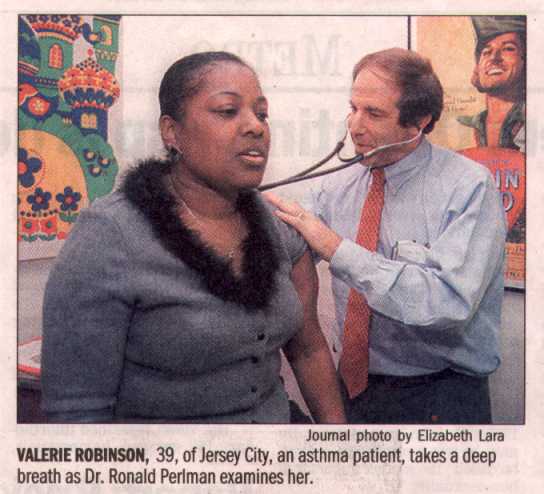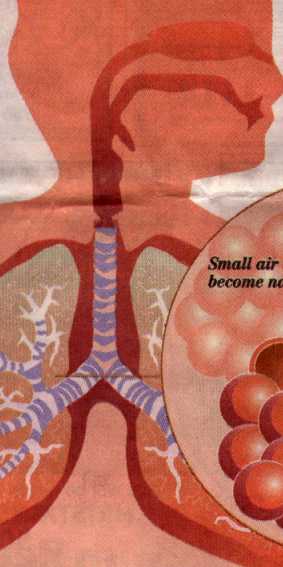Jersey City resident Rita Gathers waits in an examining room with her wheezing 8-year old son, David, who has been out of school for more than a week with asthma.
"He's been hospitalized, like, five or six times. He had a collapsed lung. He had to have a home instructor for four months at one point, because he couldn't go to school," says Gathers, whose son sits so calmly and patiently on the examining table it appears this is just part of a well-rehearsed routine.
Gathers, meanwhile, holds her 7-month-old grandchild, Jahmere Williams, whose lungs sound about as congested as the waiting room of respiratory specialist Dr. Ronald Perlman's Jersey City office on this unusually cold and windy November day.
"He's had a cold for seven months. So I'm going to have the doctor examine him, too," she says, fearing asthma might start turning up in other members of the family.
Asthma, a chronic inflamatory disease of the airways, is on the rise, particularly in children, African-Americans and women. Click on picture to left for full asthma illustration.
An estimated 17.3 million Americans suffered from asthma in 1998, including 4.8 million under the age of 18, according to the Centers for Disease Control and Prevention in Atlanta. The number is up from 6.7 million cases in 1980.
Between 1982 and 1994, the prevalence rate (the rate per 1,000 people) of asthma rose from 34.8 to 56.1, an increase of 61.2 percent. The prevalence of pediatric asthma rose over the same period, from 40.1 to 69.1 - a 72.3 percent increase.
In 1982, the rate for males, 36.5 per 1,000, was slightly higher than that for women - 33.2. By 1994, rates for both sexes were up, and the trend had reversed, with a rate of 52 for males and 60.2 for females - an 81.3 percent increase for women.
Blacks, according to the American Lung Association of New Jersey, were four times as likely as whites to be hospitalized for treatment of asthma. In addition, annual visit rates for asthma are markedly higher among blacks (228.9 per 10,000 people) than among whites (48.8 per 10,000 people).
In Hudson County's overall population of 552,387, there were 21,389 adult cases of asthma and 9,323 cases of pediatric asthma in 1997, according to statistics from the lung association. In terms of both adult and pediatric cases in New Jersey, Bergen County ranks first, Essex County second, Middlesex County third and Hudson County fourth.
"There is certainly an increase in asthma among inner-city populations," says Perlman, who is director of the new Allergy and Asthma Center at the Center for Family Health of St. Mary Hospital in Hoboken.

The center, at 122-132 Clinton St. in Hoboken, is open on the first and third Mondays of every month, from 8:30 a.m. to 11 a.m. by appointment. When Perlman isn't at the center, he is treating his own patients at his private office on Kensington Avenue in Jersey City.
Health care professionals say there are a variety of reasons why those living in the inner city have a particularly hard time fighting asthma, and why there may be such a disproportionate rate among some minority populations and children.
"Just look at our location, between the Holland and Lincoln Tunnels. There are a lot of traffic emissions," notes Dr. Abbie Jacobs, director of the Center for Family Health at St. Mary Hospital.
"And you have a lot of industry nearby. All of that relates to pollution," she says, noting that poor air quality is an obvious aggravating factor of asthma.
"There are a wide variety of reasons. There may be some socio-economic factors that enter into it," adds Dr. Richard J. Bonforte, vice president and clinical director of the Children's Medical Center of Hudson County at the Jersey City Medical Center.
"A lot of it is just urban living - living in crowded housing, lower-quality housing, poor access to health care," he says.
Living in cramped quarters means easier spread of germs that can lead to infections like colds, a common trigger for asthmatic attacks, health care professionals say. Smoking around the house when an asthmatic lives there must stop, according to doctors. Even smoking by an open window, they say, still aggravates an asthmatic's condition.
Dust mites also aggravate asthma. Thus, doctors say, it is crucial to keep the house as clean as possible.
Fluctuations in weather - cold nights and warmer days - are another aggravating factor that little can be done about. But perhaps the most difficult adjustment to make, when it comes to asthma prevention, is the elimination of pets.
"We have situations we know of where the child is sensitive to a dog or cat, and sometimes the family would rather get rid of the kid than the cat," Bonforte says with a laugh.
"Some vets do have baths that binds onto the mites on the animal's fur, and deceases the allergens. But that's really just for people with mild allergies. I would never recommend that for someone who has asthma," Jacobs says, noting that in most cases the cat simply has to go.
Even once the triggers of asthma are removed, a proper medication regimen has been prescribed and symptoms start to disappear, managing asthma can be a deceptive art. All too often, the disappearance of sypmtoms lulls patients into a false sense of security.
"With many diseases, you're either very sick and you either continue to get sick or get better," Bonforte says.
"The nature of asthma is that there are periods where you may feel very well, and then, many patients get lax about taking their medication. And that's when we get into all of these problems. That's why education is so important. People need to understand the nature of the disease."
Doctors prescribe a variety of medications. Anti-inflammatory agents such as cromolyn or nedocromil stop the development of inflammation in the lungs. Corticosteroids - not related to the steroid sometimes misused by athletes - are also used either in inhaled or oral form. Bronchodilators are generally used as "rescue medications," opening up bronchial tubes so more air can flow through.
But the trick is to medicate regularly, and in sufficient time to stop a flare-up before it occurs. Like anything else, it's all in the timing.
"The majority of time, he takes it," Rita Gathers says of her son David's medications. "And I observe him. Any little cough, and I get on top of it, so that the medication gets ahead of it."
Jacobs notes, "If you're using your inhaler more than twice a week, you are not adequately in control."
How and when asthma manifests itself is fickle. Most people who develop it are born with it. But just when they begin to suffer from it - and how badly - varies.
"We're getting people of all ages. In Hoboken, as the urban population has grown, a lot of people in their 20s and 30s who have never had it before are starting to come in. Or maybe they had it, but they only had it mildly, and they didn't realize."
One such late bloomer is Jersey City resident Viola Abdelmissih, whose watery eyes and jarring cough made it clear it was time to visit Perlman.
"I work in an office. But sometimes, I have to go out onto the floor," she says of musty conditions that can sometimes aggravate her condition.
Jersey City resident Valerie Robinson, 39, says she's had to make so many trips to the emergency room in the past that she was starting to become a fixture.
"I was hospitalized about three times in one year. And I've gone to the emergency room at least a dozen times. At least enough times that they know me at Christ Hospital," she says with a laugh that turns into a cough.
"Right now, I can feel it coming on because I've lost my sense of smell and I have shortness of breath. But I haven't really had a problem with it in a year or so," she says, noting that she finally got on a medication regimen that has helped keep her condition under control.
